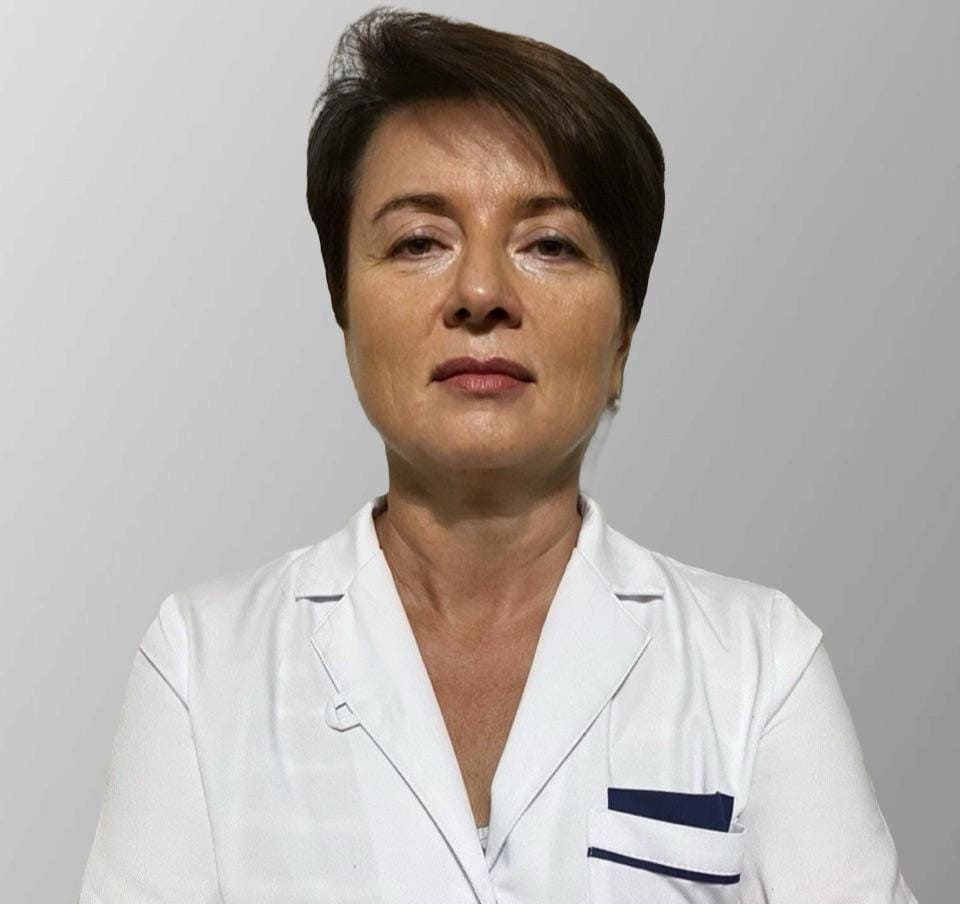
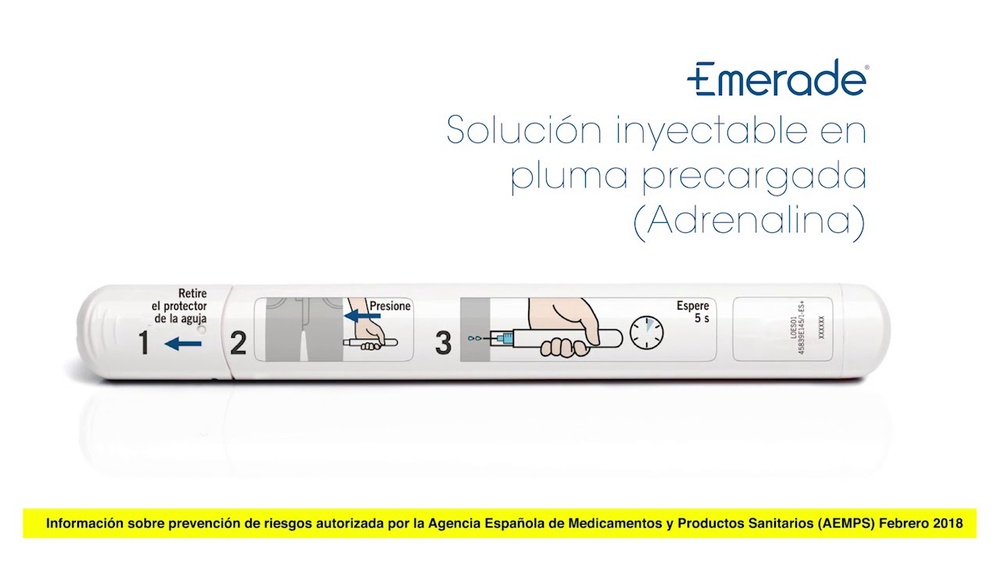
EMERADE 150 microgramas Solução injetável em caneta pré-carregada

Pergunte a um médico sobre a prescrição de EMERADE 150 microgramas Solução injetável em caneta pré-carregada

Como usar EMERADE 150 microgramas Solução injetável em caneta pré-carregada
Introdução
Prospecto: informação para o utilizador
Emerade 150 microgramas solução injetável em caneta pré-carregada EFG
Emerade 300 microgramas solução injetável em caneta pré-carregada EFG
Emerade 500 microgramas solução injetável em caneta pré-carregada
adrenalina
Leia todo o prospecto atentamente antes de começar a usar o medicamento porque contém informações importantes para si.
- Conserva este prospecto, pois pode ter que voltar a lê-lo.
- Se tiver alguma dúvida, consulte o seu médico ou farmacêutico.
- Este medicamento foi prescrito apenas para si e não deve dá-lo a outras pessoas, mesmo que tenham os mesmos sintomas que si, pois pode prejudicá-las.
- Se experimentar efeitos adversos, consulte o seu médico ou farmacêutico, mesmo que se trate de efeitos adversos que não aparecem neste prospecto. Ver seção 4.
Conteúdo do prospecto:
- O que é Emerade e para que é utilizado
- O que precisa saber antes de começar a usar Emerade
- Como usar Emerade
- Posíveis efeitos adversos
- Conservação de Emerade
- Conteúdo do envase e informação adicional
1. O que é Emerade e para que é utilizado
Emerade é um dispositivo auto-injetor que contém adrenalina em uma solução para injeção no músculo (intramuscular).
A adrenalina contrarresta a queda da pressão arterial nas reações anafilácticas. Também estimula o coração e facilita a respiração.
Emerade é utilizado como tratamento de emergência nas reações alérgicas graves (anafilaxia) causadas por alérgenos de alimentos, medicamentos, mordeduras ou picadas de insetos e outros alérgenos, assim como nas desencadeadas pelo exercício ou por causas desconhecidas.
2. O que precisa saber antes de começar a usar Emerade
O seu médico explicou-lhe quando e como deve utilizar Emerade. Se não estiver completamente seguro ou tiver dúvidas, deve contactar o seu médico.
Advertências e precauções
Emerade sempre pode ser utilizado durante uma emergência de tipo alérgico. Se si é alérgico (hipersensível) ao metabisulfito de sódio ou a qualquer um dos outros componentes de Emerade, o seu médico explicará em que circunstâncias deve utilizar Emerade.
Consulte o seu médico antes de começar a usar Emerade se si apresentar:
- uma doença cardíaca,
- pressão arterial elevada,
- hiperfunção da glândula tireoide,
- diabetes,
- um tumor da glândula suprarrenal,
- aumento da pressão do olho (glaucoma),
- redução da função renal,
- doença da próstata,
- níveis baixos de potássio ou níveis altos de cálcio no sangue.
Se si tem asma pode apresentar maior risco de reação alérgica grave.
Qualquer pessoa que tenha sofrido um episódio de anafilaxia deve procurar um médico e fazer testes de substâncias a que possa ser alérgico, para poder evitá-las no futuro. É importante ter em conta que uma alergia a uma substância pode dar origem a alergias a outras substâncias relacionadas.
Se si apresenta alergia a algum alimento é importante que verifique a composição de tudo o que ingere (incluindo os medicamentos), pois mesmo quantidades pequenas podem causar reações graves.
Também existe maior risco de aparecimento de efeitos adversos em pessoas idosas ou grávidas.
Devem ser seguidas cuidadosamente as instruções de uso, para evitar uma injeção acidental.
Emerade deve ser injetado por via intramuscular na parte externa da coxa. Não se deve injetar na nádega devido ao risco de injeção acidental em uma veia.
Advertências
A injeção acidental nas mãos ou pés pode dar origem a redução do fluxo sanguíneo na zona afetada. Se se produzir uma injeção acidental nessas zonas, deve procurar imediatamente o serviço de urgências mais próximo para receber tratamento.
Se si tem uma camada de gordura subcutânea grossa, existe o risco de que uma única dose de Emerade não seja suficiente. Isso poderia aumentar a necessidade de uma segunda injeção de Emerade. Siga cuidadosamente as instruções de uso dadas na seção 3.
Crianças
Emerade não deve ser utilizado em crianças com menos de 15 kg.
No caso das crianças menores de 15 kg, não se pode administrar uma dose abaixo de 150 microgramas com suficiente precisão, e por tanto não se recomenda o seu uso a não ser que se trate de uma situação potencialmente mortal e sob aconselhamento médico.
Uso em desportistas:
Este medicamento contém adrenalina, que pode produzir um resultado positivo nos testes de controlo de dopagem.
Uso de Emerade com outros medicamentos
Informa o seu médico ou farmacêutico se está a utilizar, utilizou recentemente ou pode ter que utilizar qualquer outro medicamento.
Isso é particularmente importante se utilizar qualquer um dos seguintes fármacos:
- Antidepressivos como os antidepressivos tricíclicos ou os inibidores da monoaminooxidase (inibidores da MAO), pois os efeitos da adrenalina podem aumentar.
- Medicamentos para tratar a doença de Parkinson, como os inibidores da catecol-O-metil transferase (inibidores da COMT), pois podem aumentar o efeito da adrenalina.
- Medicamentos que podem fazer com que o coração tenda a apresentar batimentos irregulares (arritmias), como a Digitalis e a quinidina.
- Medicamentos denominados alfa ou beta bloqueantes para doenças cardíacas ou alterações do sistema nervoso, pois podem reduzir o efeito da adrenalina.
Os pacientes diabéticos devem controlar cuidadosamente os níveis de glicose após o uso de Emerade, pois a adrenalina pode aumentar o nível de glicose no sangue.
Gravidez e amamentação
Se está grávida ou em período de amamentação, acredita que possa estar grávida ou tem intenção de engravidar, consulte o seu médico ou farmacêutico antes de utilizar este medicamento.
A experiência sobre a utilização de adrenalina durante a gravidez é limitada. No entanto, embora estivesse grávida, não deve evitar o uso de Emerade em uma situação de urgência em que a sua vida possa estar em perigo.
Si pode amamentar o seu filho após ter utilizado Emerade.
Condução e uso de máquinas
É pouco provável que a capacidade para conduzir e utilizar máquinas seja afetada pela administração de uma injeção de adrenalina, mas poderia estar afetada por uma reação alérgica grave. Se essa capacidade estiver afetada, não deve conduzir.
Emerade contém metabisulfito de sódio
Em raros casos, o metabisulfito de sódio pode causar reações de hipersensibilidade graves ou dificuldade respiratória (broncoespasmo). Se si é alérgico (hipersensível) a metabisulfito de sódio, o seu médico explicará em que circunstâncias deve utilizar Emerade.
Emerade contém sódio
Este medicamento contém menos de 1 mmol de sódio (23 mg) por dose, isto é, essencialmente “isento de sódio”.
3. Como usar Emerade
Certifique-se sempre de ter recebido formação no uso de Emerade e siga exatamente as instruções de Emerade indicadas pelo seu médico. Em caso de dúvida, consulte o seu médico ou farmacêutico.
Verifique a data de validade dos seus auto-injetores de adrenalina e solicite ao seu médico ou enfermeira que lhe prescreva uns novos antes de que caduquem. Os injetores caducados podem não funcionar.
Emerade deve ser utilizado imediatamente se começarem os sinais ou sintomas de uma reação alérgica aguda (anafilaxia). As reações podem aparecer a poucos minutos após o contacto com o alérgeno e os sintomas podem ser, por exemplo, erupção na pele, sofocos ou inchação. As reações mais graves também afetam a circulação sanguínea e a respiração.
Antes de que surja a necessidade de utilizar Emerade, certifique-se de que compreende em que situações deve utilizá-lo. Se apresenta risco de anafilaxia, é importante que sempre leve duas canetas de adrenalina consigo todo o tempo. Emerade deve ser guardado na caixa original, embora durante o transporte pelo paciente/cuidador seja aceitável guardá-lo no envase especialmente projetado em que é entregue. Deve levar sempre a caneta nesse envase para assegurar a proteção da caneta e da etiqueta que mostra como utilizá-la em uma situação de emergência. Guarde sempre este folheto informativo no estojo.
Posologia
A dose será decidida pelo seu médico, que ajustará a dose individualmente, por exemplo dependendo do seu peso corporal.
Adultos
Adultos com menos de 60 kg de peso
A dose habitual é de 300 microgramas
Adultos com mais de 60 kg de peso
A dose habitual é de 300 a 500 microgramas
Crianças e adolescentes
Não se recomenda o uso de Emerade 500 microgramas em crianças.
Crianças entre 15 e 30 kg de peso
A dose habitual é de 150 microgramas.
Crianças com mais de 30 kg de peso
A dose habitual é de 300 microgramas.
Adolescentes com mais de 30 kg de peso
Devem ser seguidas as recomendações indicadas para adultos.
Como se administra Emerade
Devem ser seguidas cuidadosamente as instruções de uso, para evitar uma injeção acidental.
Recomenda-se que os seus familiares, cuidadores ou professores também recebam instruções sobre como administrar corretamente Emerade
Emerade só deve ser utilizado injetando-o na parte externa da coxa ante os primeiros sinais de uma reação alérgica grave. A injeção é administrada ao pressionar Emerade contra a coxa. Pode ser administrado atravessando a roupa. Não se deve injetar na nádega (o traseiro).
Se uma caneta de adrenalina Emerade não se activar, imediatamente se deve fazer uma tentativa adicional usando uma força maior ao pressionar a caneta contra o local de injeção previsto.
Se não tiver sucesso, proceda imediatamente a utilizar a sua segunda caneta.
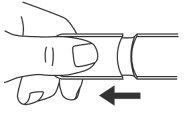
- Retire o tampão.
 Coloque Emerade contra a parte externa da coxa com um ângulo de 90º e pressione firmemente para que o protetor da aguja se retrate. Ouça um "clic" quando o dispositivo se active e a aguja penetre na coxa.
Coloque Emerade contra a parte externa da coxa com um ângulo de 90º e pressione firmemente para que o protetor da aguja se retrate. Ouça um "clic" quando o dispositivo se active e a aguja penetre na coxa.
e
 Mantenha Emerade completamente pressionado contra a coxa durante 5 segundos. A seguir, massageie ligeiramente a zona da injeção.
Mantenha Emerade completamente pressionado contra a coxa durante 5 segundos. A seguir, massageie ligeiramente a zona da injeção.
- Procure atendimento médico imediatamente.
A agulha de Emerade está protegida antes, durante e após a injeção.
Quando se completa a injeção, o protetor da agulha de Emerade aparece visivelmente mais longo e o êmbolo está visível na janela de inspeção ao levantar a etiqueta.
Mensagens-chave para os pacientes:
- Às vezes, uma única dose de adrenalina não é suficiente para contrariar totalmente os efeitos de uma reação alérgica grave. Por esta razão, o seu médico deve prescrever-lhe duas canetas Emerade.
- Se os seus sintomas não melhoraram ou pioraram nos 5 - 15 minutos após a primeira injeção, bem si ou a pessoa com quem está deve administrar-lhe uma segunda. Por esta razão, deve levar duas canetas de Emerade consigo todo o tempo.
- Emerade está projetado como tratamento de emergência. Imediatamente após a utilização de Emerade sempre se deve procurar atendimento médico. Peça a alguém que permaneça consigo até que chegue a ambulância, por si voltar a se sentir mal.
- Ligue para o 112, peça uma ambulância e indique que é um caso de 'anafilaxia’,mesmo que pareça que os sintomas estão melhorando. Deverá ir ao hospital para observação ou para receber mais tratamento, conforme necessário. Isso deve-se ao fato de que algum tempo depois pode voltar a aparecer a reação. Leve consigo a caneta utilizada.
- Enquanto espera a ambulância deve permanecer deitado com os pés elevados, a não ser que esta posição não lhe permita respirar, caso em que deverá sentar-se erguido.
- Os pacientes inconscientes devem ser colocados de lado, em posição de recuperação.
Após a utilização da caneta de Emerade seguindo as instruções, o paciente pode verificar se a caneta se ativou. As imagens abaixo (Fig.1-Fig.2) referem-se a todas as doses de Emerade (150 microgramas, 300 microgramas e 500 microgramas).
A caneta Emerade sem usar (antes da ativação) tem o protetor da agulha na sua posição normal (Fig. 1).
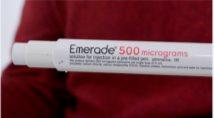
Fig 1.
A caneta de Emerade que se ativou terá o protetor da agulha estendido (Fig. 2).
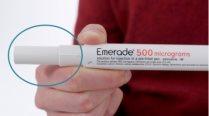
Fig. 2
Se o protetor da agulha não estiver estendido, a caneta não se ativou.
Uma caneta de Emerade que se ativou e administrou com sucesso uma dose de adrenalina, mostrará um êmbolo colorido na janela de inspeção (que se revela ao levantar a etiqueta da caneta):
150 microgramas: amarelo
300 microgramas: verde
500 microgramas: azul.
Se a janela de inspeção continuar a mostrar um líquido transparente (solução de adrenalina), a caneta não administrou corretamente uma dose de adrenalina. A seta na etiqueta da caneta indica onde se pode levantar a etiqueta para revelar a janela de inspeção.
Não retire o tampão a não ser que seja necessário administrar a injeção.
Após a injeção pode que reste um pouco de líquido no auto-injetor. O auto-injetor não pode ser reutilizado.
Há auto-injetores sem agulha (canetas para demonstração) disponíveis para formação.
Por favor, consulte o seu médico.
Se usar mais Emerade do que deve
Se se administrar uma dose maior ou se se injetar Emerade acidentalmente em um vaso sanguíneo ou na mão, deve procurar atendimento médico imediatamente.
A sua pressão sanguínea pode aumentar de forma brusca. A sobredose pode causar um aumento repentino da pressão sanguínea, batimento cardíaco irregular e acúmulo de líquido nos pulmões, o que pode dificultar a respiração.
Em caso de sobredose ou ingestão acidental, consulte imediatamente o seu médico ou farmacêutico ou ligue para o Serviço de Informação Toxicológica, telefone 915620420, indicando o medicamento e a quantidade ingerida.
Se tiver alguma outra dúvida sobre o uso deste produto, pergunte ao seu médico ou farmacêutico.
4. Posíveis efeitos adversos
Como todos os medicamentos, este medicamento pode produzir efeitos adversos, embora nem todas as pessoas os sofram.
Os seguintes efeitos adversos baseiam-se na experiência com o uso de adrenalina, embora não se possa estimar a sua frequência:
- problemas cardíacos, como batimento cardíaco rápido e irregular, dor torácica,
- aumento da pressão sanguínea, estreitamento dos vasos sanguíneos,
- sudorese,
- náuseas, vómitos,
- dificuldade para respirar,
- dor de cabeça, tonturas,
- fraqueza, tremores,
- ansiedade, alucinações,
- desmaio,
- alterações nos valores no sangue, como aumento do açúcar no sangue, redução do potássio e maior acidez
Comunicação de efeitos adversos
Se experimentar qualquer tipo de efeito adverso, consulte o seu médico ou farmacêutico, mesmo que se trate de possíveis efeitos adversos que não aparecem neste prospecto. Também pode comunicá-los diretamente através do Sistema Espanhol de Farmacovigilância de Medicamentos de Uso Humano https://www.notificaRAM.es
Ao comunicar efeitos adversos, si pode contribuir para fornecer mais informações sobre a segurança deste medicamento.
5. Conservação de Emerade
Mantenha este medicamento fora da vista e do alcance das crianças.
Conservar no envase protetor de plástico em que é entregue. O envase de plástico que contém a caneta/canetas pode ser guardado na caixa exterior.
Conservar abaixo de 25 ºC. Não congelar.
Não utilize este medicamento após a data de validade que aparece na etiqueta e na caixa exterior. A data de validade é o último dia do mês que se indica. Após a data de validade, elimine Emerade e substitua-o por outro envase. Examine periodicamente a solução através da janela de inspeção, levantando a etiqueta, para assegurar-se de que a solução continua a ser transparente e incolor. Não utilize este medicamento se observar que a solução mudou de cor ou contém algum precipitado.
Revise o auto-injetor se se lhe cair. Substitua-o se observar algum dano ou fuga.
Os medicamentos não devem ser jogados nos esgotos nem na lixeira. Deposite os envases e os medicamentos que não precisa no ponto SIGRE da farmácia. Em caso de dúvida, pergunte ao seu farmacêutico como se livrar dos envases e dos medicamentos que já não precisa. Dessa forma, ajudará a proteger o meio ambiente.
6. Conteúdo do envase e informação adicional.
Composição de Emerade
O princípio ativo é adrenalina na forma de tartrato.
Emerade 150 microgramas libera 150 microgramas de adrenalina em 0,15 ml de solução.
Emerade 300 microgramas libera 300 microgramas de adrenalina em 0,3 ml de solução.
Emerade 500 microgramas libera 500 microgramas de adrenalina em 0,5 ml de solução.
Os outros componentes são: cloreto de sódio, metabisulfito de sódio (E223), edetato de disódio, ácido clorídrico e água para preparações injetáveis.
Aspecto de Emerade e conteúdo do envase
Emerade é um autoinjetor que libera uma única dose de adrenalina. Emerade contém uma solução para injeção, transparente e incolor, dentro de uma seringa de vidro. Emerade não contém látex.
O dispositivo é um cilindro branco com um protetor que cobre a agulha e com um mecanismo de gatilho.
Comprimento da agulha exposta:
Emerade 150 microgramas: 16mm
Emerade 300 microgramas e 500 microgramas: 23mm.
Tamanhos de envase: 1 ou 2 canetas precarregadas.
Pode ser que nem todos os tamanhos de envase estejam comercializados.
Titular da autorização de comercialização e responsável pela fabricação
Titular
PharmaSwiss Ceská republika s.r.o.
Jankovcoca 1569/2c, 170 00 Praga 7.
República Checa.
Responsável pela Fabricação
Rechon Life Science AB
Soldattorpsvägen 5, SE-216 13 Limhamm.
Suécia
Data da última revisão deste prospecto: Dezembro 2021
A informação detalhada e actualizada deste medicamento está disponível na página web da Agência Española de Medicamentos y Productos Sanitarios (AEMPS)http://www.aemps.gob.es/
Pode aceder a informação detalhada e actualizada sobre este medicamento escaneando com o seu telemóvel (smartphone) o código QR incluído no prospecto. Também pode aceder a esta informação na seguinte direção de internet:
https://cima.aemps.es/info/80146
https://cima.aemps.es/info/80147
https://cima.aemps.es/info/80149

- País de registo
- Disponibilidade em farmáciasProblema de disponibilidade reportado
- Substância ativa
- Requer receita médicaSim
- Fabricante
- Esta informação é apenas para referência e não constitui aconselhamento médico. Consulte sempre um médico antes de tomar qualquer medicamento. A Oladoctor não se responsabiliza por decisões médicas baseadas neste conteúdo.
- Alternativas a EMERADE 150 microgramas Solução injetável em caneta pré-carregadaForma farmacêutica: INJETÁVEL, 1 mg/10 mlSubstância ativa: epinephrineFabricante: Laboratoire AguettantRequer receita médicaForma farmacêutica: INJETÁVEL, Adrenalina base 1 mg/mlSubstância ativa: epinephrineFabricante: B Braun Medical S.A.Requer receita médicaForma farmacêutica: INJETÁVEL, 1 mg/mlSubstância ativa: epinephrineFabricante: Laboratorios Basi Industria Farmaceutica S.A.Requer receita médica
Alternativas a EMERADE 150 microgramas Solução injetável em caneta pré-carregada noutros países
As melhores alternativas com o mesmo princípio ativo e efeito terapêutico.
Alternativa a EMERADE 150 microgramas Solução injetável em caneta pré-carregada em Польща
Alternativa a EMERADE 150 microgramas Solução injetável em caneta pré-carregada em Україна
Médicos online para EMERADE 150 microgramas Solução injetável em caneta pré-carregada
Avaliação de posologia, efeitos secundários, interações, contraindicações e renovação da receita de EMERADE 150 microgramas Solução injetável em caneta pré-carregada – sujeita a avaliação médica e regras locais.



